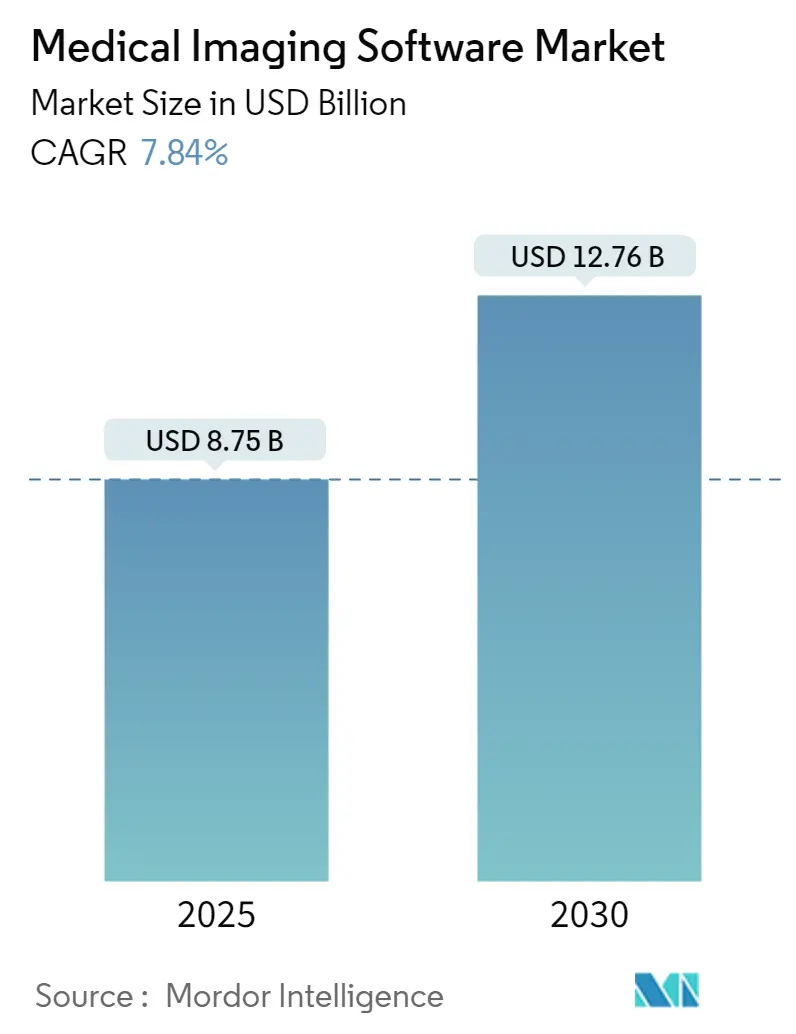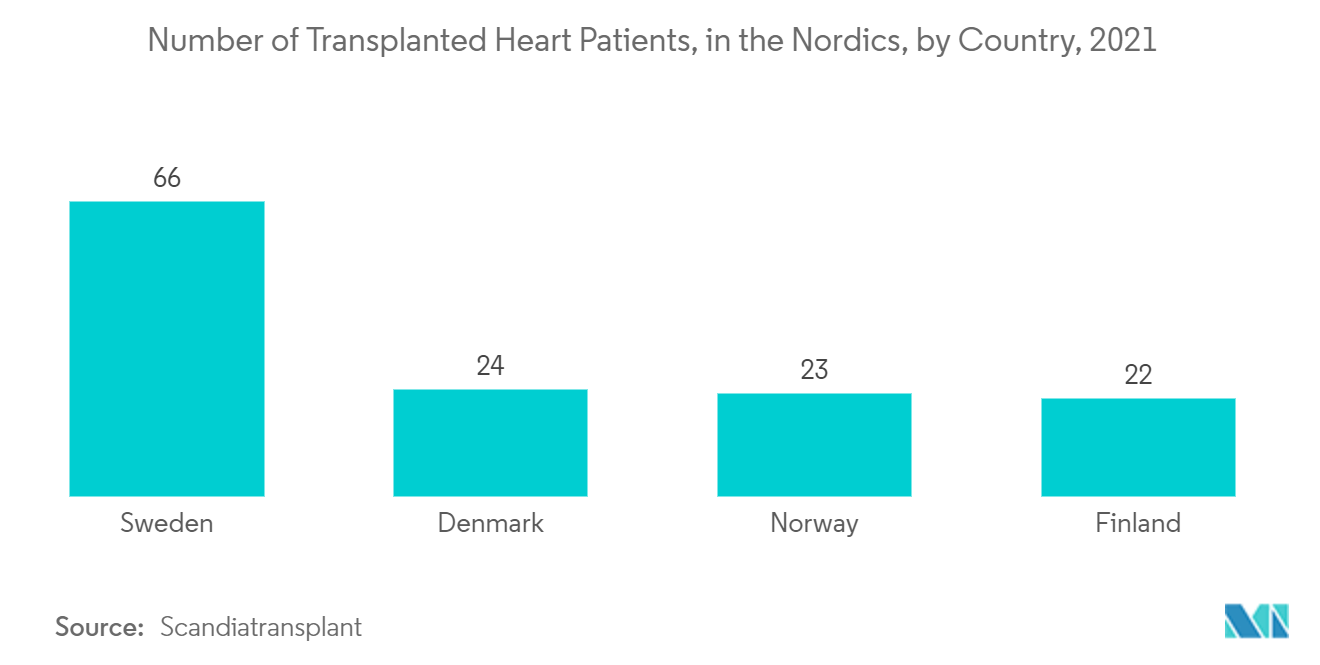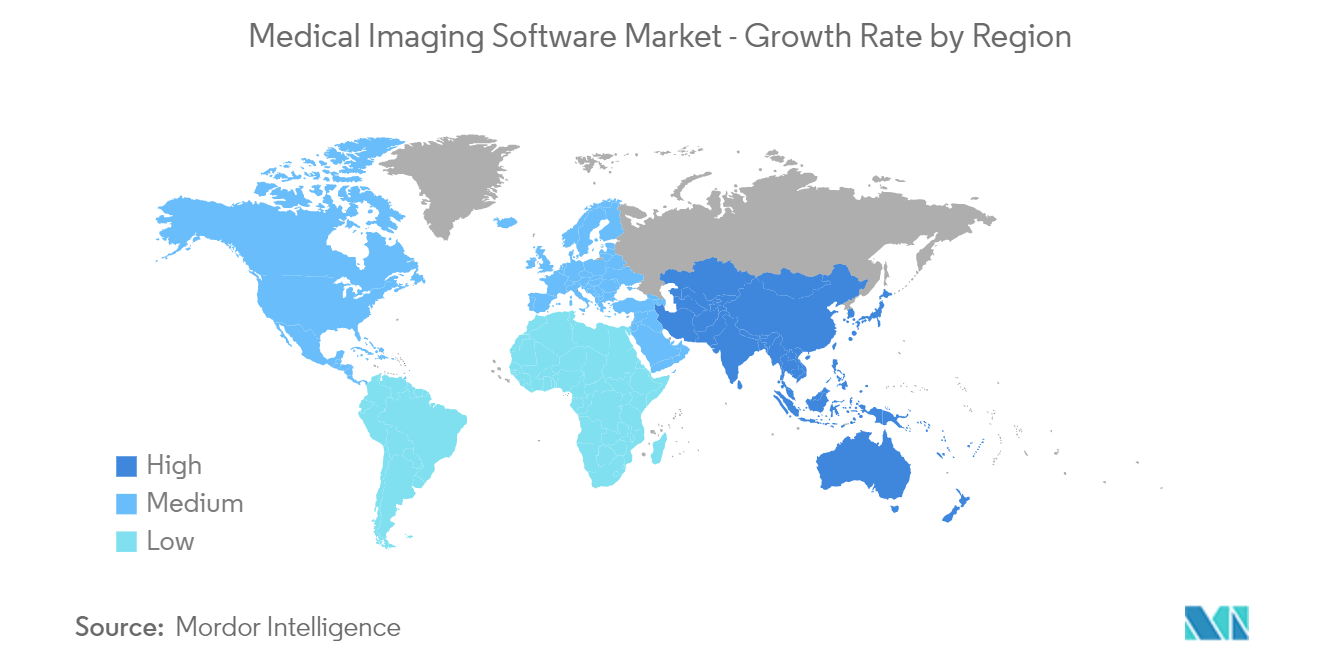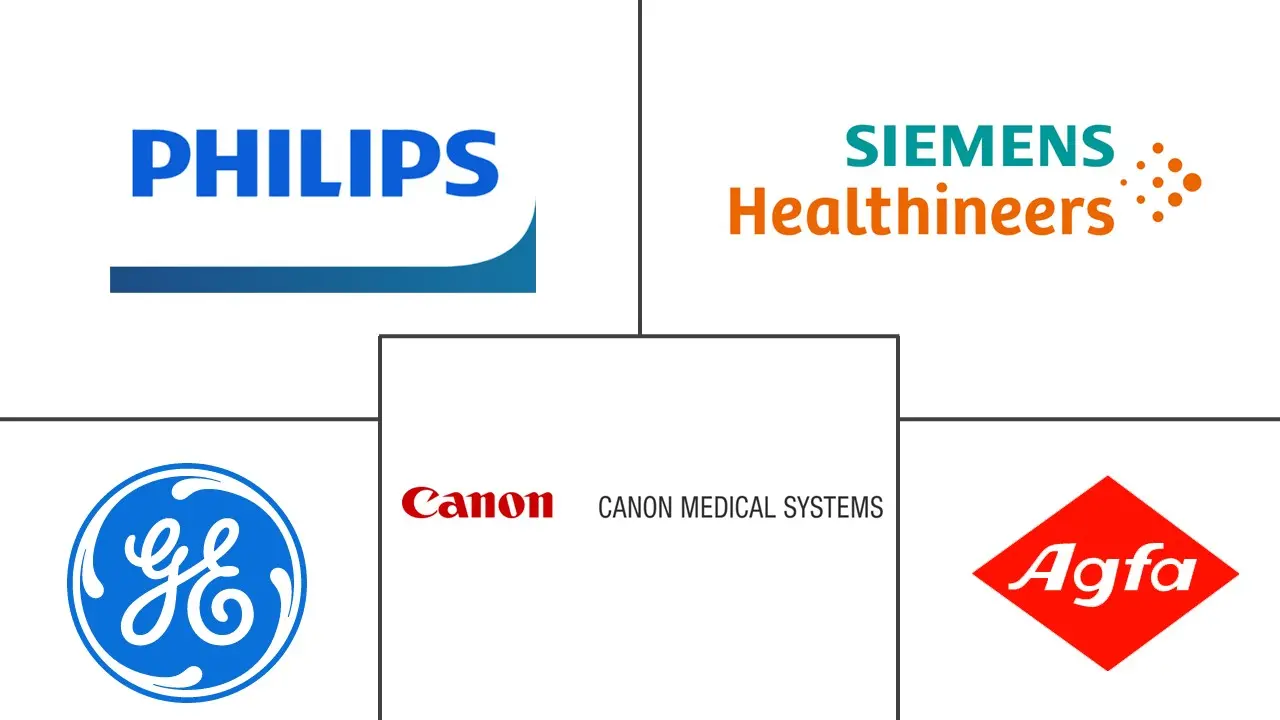
Medical Imaging Software Market Analysis by Mordor Intelligence
The Medical Imaging Software Market size is estimated at USD 8.75 billion in 2025, and is expected to reach USD 12.76 billion by 2030, at a CAGR of 7.84% during the forecast period (2025-2030).
Machine learning and artificial intelligence have attracted the healthcare industry as these innovative analytics strategies have become more accurate and precise.
- The need for medical imaging software for advanced treatment for people with arthritis, cancer, etc., demands an advanced version. This advanced image is used to advance patient care and improve operating productivity by empowering doctors and other healthcare professionals by providing more details about patient conditions.
- An increase in demand for diagnostic imaging software in applications such as dental, Orthopedic, Cardiology, obstetrics and gynecology, Mammography, urology, and neurology, is expected to contribute to the market growth.
- The increasing use of ultrasonic imaging equipment for earlier diagnosis, particularly chronic disorders, is likely to drive the market's demand. Furthermore, ongoing advancements in imaging technologies, such as Computer-aided Diagnosis (CAD), are expected to boost demand for these systems. The adoption of Artificial Intelligence (AI) in medical imaging has transformed market trends in recent years and is expected to impact future growth positively.
- The high cost of imaging equipment, combined with the increased implementation and licensing fees of software, is the biggest constraint to market expansion, particularly in countries with poor reimbursement scenarios. For example, most healthcare facilities in developing nations, such as hospitals and diagnostic centers, have costs.
- During the COVID-19 pandemic, various AI, machine learning, and deep learning technologies were applied in medical image processing, which will drive market expansion further. Because of the increasing demand for efficient solutions for better patient outcomes, diagnostic and research institutes are expected to emerge as significant end users of image analysis solutions. Due to the technological advancements in medical applications, the market is increasing after the pandemic.
Global Medical Imaging Software Market Trends and Insights
Cardiology Applications Segment Holds Major Market Share
- As the frequency of chronic diseases related to the heart is increasing globally, the demand for medical imaging software is increasing. With such rising demand, prominent market players are focusing on R&D and new product launches, as well as joint ventures and acquisitions, to develop their businesses.
- For instance, in March 2022, Philips announced Health Suite Interoperability, a fully integrated cloud-enabled Health IT platform designed to address the different workflow demands of the imaging industry.
- Medical image software has been found to improve analysis speed and accuracy. Key players around the globe are integrating emerging technologies like AI and Cloud computing to introduce new medical imaging software applications. For instance, Arterys, located in San Francisco, combines deep learning AI algorithms with cloud computing. Arterys designed for cardiac MRIs to assist in identifying abnormal lesions in these areas.
- In February 2022, Cleery launched Cleerly 2.2.0, a new software version that tracks heart disease based on the quantity and kind of atherosclerosis. Such market innovations and new product releases contribute to expanding the Medical Imaging Software Market Size.
- In Cardiac problems like heart transplantation, medical imaging software is used to know the volumetric and functional data analysis. According to Scandiatransplant, the number of heart transplant recipients in the Nordic countries in 2021 Sweden had the most significant number of transplanted heart patients, with 66 individuals transplanted a new heart. Denmark had the second-highest number of transplants, with 24 patients.

North America is Expected to Register the Largest Market
- North America is expected to be the largest market for medical imaging software globally. The region has a considerably high level of investments in medical infrastructure, especially in countries like the United States, Mexico, and Canada. This scenario, coupled with the increasing multitude of hardware in the region, is expected to boost the demand for medical imaging software.
- The expansion can be attributed to the availability of well-established healthcare institutions equipped with modern diagnostic equipment and favorable government measures to boost the use of healthcare IT in this region. Furthermore, rising R&D investments and the presence of significant market competitors are fueling regional market expansion.
- In October 2022, Enlitic, one of the leading healthcare IT firms, announced a new partnership with MULTI Inc., a healthcare technology provider of authentic parts, equipment, and services. The two organizations collaborated to provide the Enlitic Curie platform to healthcare providers across the United States to assist radiology departments in driving operational efficiencies. As the need for high-quality patient care grows, hospital leaders focus on building more efficient operations while expanding revenue prospects that contribute to better patient outcomes. To achieve these aims, the Curie|ENDEX application impacts the workflows of several users within the radiology department.
- As a result, many medical imaging software vendors are moving towards vendor-neutral archive (VNA) technologies that enable access to images form several networks and the ability to integrate them with third-party or centralized Electronic Health Record (HER) systems.
- According to the American Cancer Society estimation in January 2022, the number of new lung and bronchus cancer cases registered in the United States is 2,36,740. The highest number of these cases is estimated to be in Florida. The increase in cancer patients necessitates the use of medical imaging software.

Competitive Landscape
The competitive rivalry in this market is high because of dominant players like General Healthcare Company (GE), Koninklijke Philips N.V., Siemens Healthcare, Canon Medical Systems Corporation, and Agfa Gevaert HealthCare, among others. The industry players constantly develop their product portfolios to gain competitive advantages with mergers and acquisitions, partnerships, and constant innovations.
- June 2022 - Canon Medical Systems Corporation, which provides a full range of medical imaging solutions such as CT, MRI, Ultrasound, Eye Care, Diagnostic and Interventional X-Ray equipment, Mobile Imaging Solutions, and a full suite of Healthcare IT solutions, has expanded its partnership with the European Society of Radiology for the 2022 onsite edition in Vienna. Through the partnership, Canon Medical offers its medical imaging solutions to ESR patients.
Medical Imaging Software Industry Leaders
-
General Healthcare Company (GE)
-
Koninklijke Philips N.V.
-
Siemens Healthcare
-
Canon Medical Systems Corporation
-
Agfa Gevaert HealthCare
- *Disclaimer: Major Players sorted in no particular order
.webp)
Recent Industry Developments
- February 2022 - The European Society of Radiology and GE Healthcare have renewed their strategic partnership for the online European Congress of Radiology ECR 2022 on March 2-6, 2022, and onsite ECR 2022 on July 13-17 in Vienna, Austria. GE Healthcare would focus its efforts on three strategic pillars, digital and artificial intelligence, patient experience, and sustainability & resilience.
- July 2022 - At ECR 2022, Canon Medical launched the Vantage Fortian. The new MRI system includes innovative workflow solutions, image enhancement, and accelerated scan technologies, all leading to shorter MRI treatment times.
- July 2022 - Calyx and Qynapse have partnered to increase the use of AI-based neuroimaging techniques in clinical trials of therapy options for problems affecting the central nervous system (CNS) or the brain and spinal cord.
Global Medical Imaging Software Market Report Scope
Medical imaging is a part of healthcare practices across the globe that uses the latest technological advancements, software, and equipment to generate graphical representations of the interior of a body for diagnosis, clinical analysis, and medical intervention. The growing demand for healthcare services for the aging population significantly impacts the healthcare industry's growth. It is supported by medical advances and improvements in medicine and technology, affecting the demand for healthcare services. The advancement of 3D/4D platforms and multimodality imaging platforms are acting as catalysts for this market.
The market is segmented by Imaging Type (2D Imaging, 3D imaging, and 4D imaging), by Application (Dental Applications, Orthopedic Applications, Cardiology Applications, Obstetrics and Gynecology Applications, Mammography Applications and Urology and Nephrology Applications), and by Geography. The market sizes and forecasts are provided in terms of value (USD million) for all the above segments.
| 2D Imaging |
| 3D Imaging |
| 4D Imaging |
| Dental Applications |
| Orthopaedic Applications |
| Cardiology Applications |
| Obstetrics and Gynaecology Applications |
| Mammography Applications |
| Urology and Nephrology Applications |
| Other Applications |
| North America | United States |
| Canada | |
| Europe | Germany |
| France | |
| United Kingdom | |
| Rest of Europe | |
| Asia-Pacific | China |
| Japan | |
| India | |
| Rest of Asia-Pacific | |
| Rest of the World | Latin America |
| Middle-East & Africa |
| By Imaging Type | 2D Imaging | |
| 3D Imaging | ||
| 4D Imaging | ||
| By Application | Dental Applications | |
| Orthopaedic Applications | ||
| Cardiology Applications | ||
| Obstetrics and Gynaecology Applications | ||
| Mammography Applications | ||
| Urology and Nephrology Applications | ||
| Other Applications | ||
| Geography | North America | United States |
| Canada | ||
| Europe | Germany | |
| France | ||
| United Kingdom | ||
| Rest of Europe | ||
| Asia-Pacific | China | |
| Japan | ||
| India | ||
| Rest of Asia-Pacific | ||
| Rest of the World | Latin America | |
| Middle-East & Africa | ||
Key Questions Answered in the Report
How big is the Medical Imaging Software Market?
The Medical Imaging Software Market size is expected to reach USD 8.75 billion in 2025 and grow at a CAGR of 7.84% to reach USD 12.76 billion by 2030.
What is the current Medical Imaging Software Market size?
In 2025, the Medical Imaging Software Market size is expected to reach USD 8.75 billion.
Who are the key players in Medical Imaging Software Market?
General Healthcare Company (GE), Koninklijke Philips N.V., Siemens Healthcare, Canon Medical Systems Corporation and Agfa Gevaert HealthCare are the major companies operating in the Medical Imaging Software Market.
Which is the fastest growing region in Medical Imaging Software Market?
Asia Pacific is estimated to grow at the highest CAGR over the forecast period (2025-2030).
Which region has the biggest share in Medical Imaging Software Market?
In 2025, the North America accounts for the largest market share in Medical Imaging Software Market.
What years does this Medical Imaging Software Market cover, and what was the market size in 2024?
In 2024, the Medical Imaging Software Market size was estimated at USD 8.06 billion. The report covers the Medical Imaging Software Market historical market size for years: 2019, 2020, 2021, 2022, 2023 and 2024. The report also forecasts the Medical Imaging Software Market size for years: 2025, 2026, 2027, 2028, 2029 and 2030.
Page last updated on:
Medical Imaging Software Market Report
Statistics for the 2025 Medical Imaging Software market share, size and revenue growth rate, created by Mordor Intelligence™ Industry Reports. Medical Imaging Software analysis includes a market forecast outlook for 2025 to 2030 and historical overview. Get a sample of this industry analysis as a free report PDF download.



